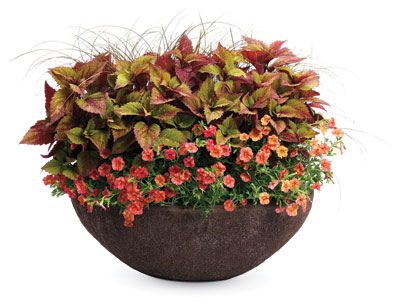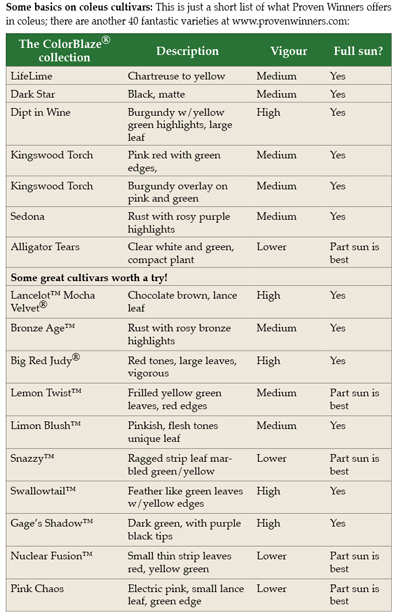
Fashions may come and go, but the brilliant colours of coleus remain with us year after year.
Fashions may come and go, but the brilliant colours of coleus remain with us year after year. The market is mostly in the “drive-by impact” of the basics (lime green, matte black and red), but a big part of the market is also based on the incredible textures and colours of some of the more subtle blends that consumers see when they enter the garden centre. In any case, the crop just continues to grow more popular, and consumers, as well as industry magazines, keep us all supplied with a steady parade of images in the landscape and in mixed containers.
 |
|
| ‘Royal Glissade’ in a combination. Advertisement
|
BASIC PRIMER ON COLEUS:LET’S BEGIN WITH THE NAME
Let’s start with the correct naming because you may find it hard to look up coleus since the plant taxonomists changed the name. The correct scientific name for this plant is Solenostemon scutellarioides, it used to be Coleus blumei, but no longer. The common name is still coleus, but if you are looking things up by scientific name, you may need to know the new name as well.
These plants originated in southeast Asia and tropical Africa. When they were first introduced into Europe and then into America, they were only considered as houseplants or shade bedding plants and didn’t tolerate sun because they naturally grew in the understorey of the jungle. Luckily, some breeding and selection has been done in the last 30 to 40 years, changing this, and we now have great full-sun cultivars, as well as some that still prefer the shade.
 |
CHOOSING THE RIGHT CULTIVAR FOR BETTER SALES NEXT SPRING
Coleus is a bit like the fashion industry – what was hot last year, may or may not be hot this year. The best information on what will sell next spring is what sold best and held up best at retail in the past. It’s pretty hard to go wrong with ‘LifeLime,’ ‘Dark Star’ and either ‘Kingswood Torch’ or ‘Dipt in Wine’ (all part of the Colorblaze® Coleus series of Proven Winners®), as these plants not only light up mixed containers, but have visual impact in the landscape as well. Having said that, a lot of consumers are working in small areas and like some of the subtler colour patterns that are not “drive-by impact.”
The other consideration is what size containers will you grow in, and therefore what vigour are you looking for? If you grow predominantly in 10 cm containers, then you’ll want to bring high-vigour cultivars into your greenhouse a little bit later – so they don’t immediately outgrow the containers. However, high-vigour cultivars can be quick cropped for spring sales very easily. When looking into growing in larger containers (25 cm plus), you’ll find a lot of lower-vigour cultivars can be slow, especially under spring’s cooler conditions.
Proven Winners took its top colours and performers and put them into the ColorBlaze series. All are moderate to high-vigour (with the exception of Alligator Tears™, which is a great small containers and/or gardens variety) with landscape performance and great close-up impact.
Back when coleus first began to become popular in the industry, almost all of it was from seed. Heck, for that matter, most all the plants we grew came from seed and over the last 50 years the vegetative breeding has really begun to change the way we do things. Seed-type coleus became a bit old-fashioned because they were very early to flower. It makes sense that if you are growing the seed crop, you will want something that sets a LOT of seed and sets it early.
However, in the end this turns out to be not such a desirable trait for consumers buying the end crop. Coleus fell out of fashion because the plants all looked tired by mid-season, flowered, dropped leaves and declined, and that is why I remember my grandmother telling me to always pinch the flowers off the plants to keep them going.
Vegetative breeding gets us around this particular problem. The vegetative lines of coleus came into the market about 20 years ago (again originating in southeast Asia) and were called “Sun Coleus.” They had been bred and selected to tolerate full, hot sun and flowered a lot later, thereby avoiding all the problems of the seed types.
One of the major breeders of new late flowering types is Dr. Dave Clark at the University of Florida. Clark selects for plants that flower later and later under Florida conditions; as a result you may never see a flower on one of his hybrids in the north. All that energy that old-fashioned types put into flowering now goes into forming more leaves and branches. Proven Winners has been bringing Clark’s varieties to the market for a while and they are always standout performers. If you don’t believe there is a difference, I highly suggest you ask a supplier for some of both types and do a bit of your own trialling.
The Netherlands has one of the most comprehensive coleus websites on the planet with pictures of all the cultivars. Check it out at www.coleusfinder.org .
GETTING YOUR MONEY’S WORTH OUT OF THE CROP
In the greenhouse: Coleus is tolerant of a variety of conditions; however, try to avoid cold, wet soil and low light levels. Remember these are tropical plants by origin and prefer warmer conditions.
 |
|
| Dr. Rick Schoellhorn, director of new products for Proven Winners PHOTOS COURTESY PROVEN WINNERS
|
Don’t put them in deep shade. Plants grown in the deep shade usually fail to develop their true colours – leaf margins start to go green and rich reds or multicoloured types overall green up and lack the impact you want at retail.
Low light also causes stretch (light is the best control of branching in this crop), which gives weaker growth and leaf substance, rendering plants more sensitive to diseases like downy mildew.
Fertilize regularly with 150 ppm nitrogen in a balanced fertilizer for the fastest crop; reduce fertilizer if you want to hold the crop.
Going to retail: Avoid allowing the plants to become chilled in cold weather conditions (around 40ºF), especially if they were not hardened off before going outside. Chilled plants will be wilted and slow to recover, and will lose lower leaves.
When putting plants into displays, mix the colours or use other flowering plants as contrast. Help consumers understand how to use the plants and you’ll sell more of them.
Dr. Rick Schoellhorn is the director of New Products for Proven Winners LLC: www.provenwinners.com , rick@provenwinners.com.
Print this page